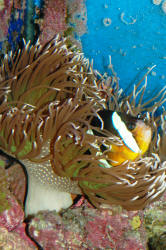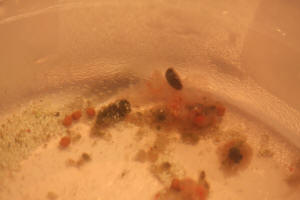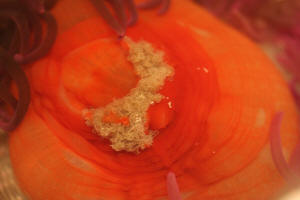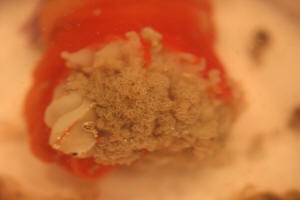|
FAQs on Long Tentacle Anemone
Stocking/Selection
Related Articles: LTAs, Anemones,
Bubble
Tip Anemones, Cnidarians, Coldwater Anemones, Colored/Dyed Anemones,
Related FAQs: LTAs
1, LTAs 2, LTA Identification, LTA Behavior, LTA
Compatibility, LTA Systems,
LTA Feeding, LTA Disease, LTA
Reproduction, Anemones 1,
Anemones 2, Anemones 3, Anemones
4, Bubble Tip
Anemones, Caribbean
Anemones, Condylactis, Aiptasia
Anemones, Other Pest
Anemones, Anemones and
Clownfishes, Anemone
Reproduction, Anemone
Lighting, Anemone Feeding,
Anemone Systems,
Anemone
Identification, Anemone
Compatibility, Anemone
Selection, Anemone Behavior,
Anemone
Health, Anemone
Placement,
Get one that's well-established, open,
feeding... with a/the clown/s if you can that you intend to keep
with it.
|

|
 |
New Print and
eBook on Amazon:
Anemone Success
Doing what it takes to keep Anemones healthy long-term
by Robert (Bob) Fenner
|
LTA 11/25/13
I just got a LTA tonight. The LFS said to turn the powerheads off
tonight to make sure it does not get caught up in it. Should there
be no flow at all overnight?
<Likely not an issue>
I noticed my Clarkii is already hosting in it.
<Ah, good... more likely the Anemone will stay put>
Thanks!
Barbara
<Cheers, Bob Fenner>
|
LTA demise 2/11/10
Although I've read and re-read various articles on various
topics since preparing for setting up our first salt water tank -
this is the first I've ventured into writing the
"crew".
<You are a stranger here but once. I welcome you>
We have a 120 gallon display tank and a 30 gallon sump with fuge
and skimmer. In addition, we run UV, Kalk, active carbon, GFO
reactor and a denitrator.
<Mmm, a note/comment: These last two chemical filters can be
too effective... removing too much necessary macro-nutrient for
chemo and mixo-trophic life (in this case, Actinarian)>
We dose vitamin C (1/4tsp 2 times daily)
<I would do this more irregularly... let's say once a
week>
and buffer KH and Ca as needed based on regular testing. We are a
mixed reef with a peaceful collection of inhabitants with about
150lbs of live rock and a deep sand bed. We run 2 T5HO lights for
12.5hours a day and 2
150W MH for 6.5 hours a day. The fuge light runs opposite the
T5HO light cycle. We control and help with monitoring everything
via a Neptune Apex controller. For water flow, we have 2 6045
power heads and a Nano wave box.
Our water parameters are generally -
KH - 12
Ca - 415
<[Mg]?>
Ph - 8.2
NO3 - <10
<[HPO4]?>
temp 77-78.5
salinity 1.025
We have had fairly good success with the items we add to our tank
- hopefully, partially due to the research and planning before we
add anything or make changes. We also have the support of an
incredible local fish store (too convenient at times...).
<Good>
That said, we had researched and decided to add a purple LTA to
our system.
We waited a while until confirming a healthy specimen from a
source we trusted. It was transported in person to an event where
we were able to pick it up.
After getting it home, knowing it had been in a shipping package
for a while, we immediately acclimated it - drip acclimation for
approximately 1 hour, being cautious of the water temp of the
container it was in. As it turned out, it was initially upside
down in the acclimation bucket (it's how it initially came
out of the bag with the water when transferring to the bucket) -
so we got a good opportunity to examine its foot for any damage.
Coloring was a nice bright red with no noticeable damage. There
were a few lighter lines on the side of its foot that reminded me
of stretch marks - but no torn tissue.
<Good>
The rock scape in our 120 is arranged in 2 islands, one larger
than the other - so the tank is open in the center. With the wave
box, we have a single center overflow box along the back and the
sand bed is a little lower just in front of the overflow box. We
had placed the LTA in that area, expecting it would like the
protection of the base rock further to either side (there is at
least 12" between them), light motion of the wave box water
movement, and the direct lighting from the lighting above. We had
arranged two smaller pieces of rock in that area initially - to
provide some protection while it settled and ideally, buried its
foot in the sand in front of the overflow box.
yes, I know that ideally
<?>
and LTAs don't mix.. :) But we wanted to start out with what
we thought would work well for it and go from there.
As it turned out, it seemed very content there. We noticed some
movement of the smaller rocks - we assumed from the shift in sand
as it buried its foot. Our skunk clowns took to it immediately,
and we were pretty sure it had eaten for us.
About 6 days later, it's disc seem over inflated and a bit
transparent from the top surface. It hadn't moved, and its
tentacles were still inflated with the same coloring - but the
over inflated disc concerned us a bit.
It's mouth was neither open or inflated.
When we fed that night, the clowns pulled everything from it and
pushed it aside (Mysis and squid). Of course, nearby fish were
happy - but we weren't.
Then yesterday (8 days after being added to our tank) - we happen
to see our clown actually push it on its side. Well - that told
us it had decided not to plant its foot - which was okay - as it
would move until it was happy. BUT, when we saw the bottom of the
foot, we saw something that alarmed us - a small 1" long
narrow section that looked like it was covered in a white
stringy, ruffed substance. It reminded me of what you see when
mushrooms get stressed - but in a longer strip, rather than out
of a single mushroom mouth.
<Is part of the inside of the Anemone itself>
Since we knew it wasn't planted, we very gently scooped it up
with some tank water into a separate container for a closer look.
Other than the mark now discovered on the foot - we weren't
seeing anything to indicate an issue - tentacles were active and
inflated, mouth closed, etc.
We opted to keep the LTA in a plastic container to contain it in
the tank for observation (plastic storage container with holes in
it and rubber bands put around it to form criss cross over the
top to prevent the LTA from floating out). Over a 12 hour period,
the area we first observed on the foot grew to 1" square,
and tentacles deflated. 12 hours after that, the entire bottom of
the foot was affected, and it had regurgitated substances out of
it's mouth - including undigested food pellets (that we feed)
and what looked like mouse droppings. In addition, when bummed,
the affected area on its foot appeared to start to fall
apart.
Sadly, at this point, we removed it entirely from the tank.
<A wise move>
I would like to think we had a healthy specimen to start with,
<Mmm, not hard to determine; hence the call for initial
quarantine, mixing of waters/ back and forth over a few weeks
time to chemically acclimate...>
and I'd like to think that we planned and prepared as best we
could. But something, or a combination of things let to the
demise of this animal - and I'd like some insight as to
what.
<Well... importantly, it should be stated (and is repeatedly
in my writings, presentations) that all Anemones are not easily
kept... and Macrodactyla, Stichodactyla species in particular,
don't have a good survival history.>
We've found plenty of articles and photos, including on this
site, regarding how the tentacles, mouth, eating, and moving are
indicators for the health and happiness of these animals - but,
we haven't found reference to signs first showing up on the
foot that then leads to its demise. Can you shed some
insight?
<Again, it's very difficult to discern initial damage...
the removal, holding, shipping of Actinarians from the wild is
likely the largest cause/source of trouble...>
Attached are pics of the foot observed on day 8 and on day 9
since receiving. Also one of the pics of the stuff it
regurgitated. I've re-sized - but you need larger pics, just
let me know.
Thanks much!
<IF you must try another Anemone, I suggest (as stated in
articles and FAQs archived on WWM) that you choose (if possible a
cloned) Entacmaea or Heteractis crispa specimen. Bob
Fenner>
|
 
 |
Keeping Anemones-Up For The Challenge? 2/2/06 Hi crew! <Hi
there! Scott F. at your service today!> I would like to thank you
for your advice because it really help me a lot. <Glad we can
help!> I have a FOWLR tank and now I would like to add some
Invertebrates, like snail, crabs, shrimps, etc. as well one LTA, I
always put my fishes to QT before I put them on my display tank to
prevent diseases. <Music to my ears!> I'd like to know if I
have to Quarantine what I'm going to Get, and if I do, for how
long? And what do I need to look to know if there is a disease.
<Okay. Here a re links to a couple of articles I wrote on the topic
a couple of years back, which should give you a good general idea of
the process: http://www.wetwebmedia.com/QuarMarFishes.htm http://www.wetwebmedia.com/quarinverts.htm > Can I keep a
LTA and 1 Purple Tube Anemone* *on a 55g with Coralife 48" Lunar
Aqualight 4x65 260 Watts, a wet dry 75pro and about 50 pounds of live
rock and 1 Ocellaris Clownfish, 1 Bluefin Damsel, 1 Yellow Watchman
Goby, 1 large Engineer Goby and 1 Green Brittle Star. I appreciate your
response an advance. Thank you Sincerely K4Z3KY <Well, K- I'm a
bit hesitant to recommend the LTA for a system illuminated by anything
less than metal halides, as these lights will generally assure that
you're providing the proper intensity and spectrum (if you choose
the light bulb), removing at least one of the major hurdles in anemone
husbandry (lighting). Also, I would not keep multiple anemones in this
sized aquarium, as they may engage in a form of "chemical
warfare" that could stress and/or kill both specimens. You'll
still have the challenge of maintaining high water quality, providing
good food, and enough space for the animals. My candid advice would be
to try some less expensive, more abundant, and typically easier-to-keep
Condylactis anemones. Though not as "sexy" as the LTA or Tube
Anemones, these Caribbean anemones are colorful and interesting, and
have the added bonus of living a very long time in aquaria. You still
will have to provide excellent environmental conditions, but if
you're up to the challenge, they are great to work with. Good luck!
Regards, Scott F.>
-Surprise! You've got a LTA!- Hello, Background: I am new
to the salt water hobby. Have put in a 20gal tank at work (stress
reliever :-) ) as a test to learn about salt aquariums and do my trial
& error before investing huge dollars in a 150+ at home. For approx
3 months tank had a 1 Scarlet cleaner shrimp, 1 blue damsel and 1
yellow tail damsel. Tank has been doing fine and water test from the
fish store are "OK" (after reading through your site, I am
getting a test kit to obtain "exact" numbers or ranges).
<Excellent> Anyhow, the kids & wife decided to surprise me
with a maroon clown and long tentacle anemone (I know this is probably
a little over the limit for 20gal). <You may want to suggest
gift-certificate surprises in the future...> Put them in and clown
is doing fine, very active. Anemones I know nothing about which leads
me to write. <Anemones are reasonably difficult to keep, and should
only be attempted by a seasoned coral enthusiast with the proper system
and information, that's why they don't make a good
surprise!> Situation: The anemone crawled around a little at first
and now seems to like a spot in the back corner on crushed coral floor.
There is a moderate current in the tank and the anemone puts his
tentacles up in ballet motion with the current (not sure what he does
at night - also running a Marine Glo (blue lamp) and Power Glo (white
lamp)). <Unfortunately, you don't have nearly enough light to
keep this critter alive> Color of the anemone is basically a milky
translucent white. <This anemone is what we call
"bleached". That means that it has lost it's symbiotic
algae <zooxanthellae> that allows it to use the light (a large
portion of it's daily energy comes from this algae). So we have two
problems here, no internal algae to photosynthesize, nor the light to
get it accomplished anyhoo.> He does seem to change colors on the
disk area from time which is one concern/question (sometimes a pinky
looking color - not sure if this is from contracting and expanding).
<Could be> The tentacles when extended are translucent turning to
a pretty light translucent green at the tips. From time to time he will
draw a section of them in and they look shriveled and a pale green
color, is this normal? <Nope> Also the base where these draw up,
at times, will look kind of pale gray. The stalk or base is a bright
orange. The base also has long stringy mucus looking material attached
from time to time. Should this stay or be cleaned (removed). <I
would leave it, it may be it's own slime, hopefully the base
hasn't been damaged.> A few days after putting him in there, I
went and had the water tested again and they said the nitrates or
nitrites (don't remember which) was a little high <Whoa, big
deal here. Nitrites are exceptionally toxic at even the lowest levels
where nitrates are not toxic until they're in the hundreds of ppm.
A distinction needs to be made here, and quick!> and to add Nitromax
for about a week to bring it down. So basically is the color and
actions of the anemone normal and is there anything else I should be
doing? <You need to do a lighting upgrade; potentially a system
upgrade. Check out these anemone lighting FAQ's
http://www.wetwebmedia.com/marine/inverts/cnidaria/anthozoa/anemonelightngfaqs.htm,
and I'd suggest that you purchase Joyce Wilkerson's book
entitled Clownfish. This book has spectacular anemone husbandry
information. You'll need at least 2 full length sets of power
compact or VHO lighting at a minimum to keep the critter happy in the
long term, preferably metal halide lighting. First, pick up the book,
and second write back with your system specs and we can take it from
there. Good luck! -Kevin> Thanks for all the help and all the
knowledge you share! Bill
Dyed long tentacle 6/31/05 I was just
at my LFS and I saw a long tentacle anemone that was a deep purple. Do
you think there is a high possibility of it being dyed? the worker at
the LFS said he wanted it......I was about to say you're selling a
dyed anemone for a higher price than the healthy ones! how dumb are
you?... I would appreciate your opinion. Thanks a lot- Aaron <Could
be dyed... but there are LTAs that are this color naturally. Bob
Fenner>
|
|

